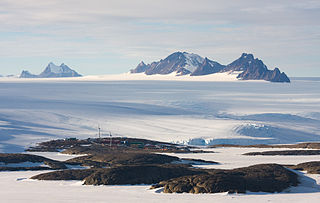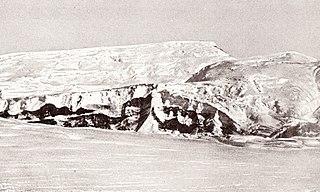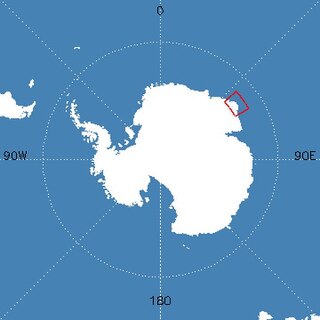
Scott G. Borg is an American geologist and civil servant. Since 1 September 2017 he has been the Deputy Assistant Director of the Directorate for Geosciences at the United States' National Science Foundation (NSF). [1] [2]

Scott G. Borg is an American geologist and civil servant. Since 1 September 2017 he has been the Deputy Assistant Director of the Directorate for Geosciences at the United States' National Science Foundation (NSF). [1] [2]
Borg graduated from Pomona College with a B.A. in geology, and earned M.S. and Ph.D. degrees from Arizona State University, where his doctoral dissertation was titled Granitoids of Northern Victoria Land, Antarctica (Tectonics, Neodymium-isotopes, Geochemistry, Petrology, Strontium-isotopes). [3] [4]
He began his career as a researcher at the University of California at Berkeley. [3] He later worked for the United States Department of Energy, and subsequently joined the staff of the National Science Foundation. [3] [5] Between 2003 and 2016 he was director of the Division of Antarctic Sciences at the National Science Foundation, [5] and in 2016-17 he served as the acting Section Head for Antarctic Infrastructure and Logistics (AIL) within the National Science Foundation Division of Polar Programs. [3] [6] In 2017, he began serving as associate director for geosciences at the National Science Foundation. [3] [7] [8]
Borg has participated in a total of six research expeditions to Antarctica, four of which he has led. [3] During a 1978–1979 expedition in which he participated, the Sagehen Nunataks were first visited, receiving their name from the Pomona Sagehens, athletic moniker of Borg's alma mater Pomona College. [9] During the same expedition, Borg named Tongue Peak, choosing the name from a tongue-shaped moraine on the peak. [10]
In 1994, Borg Bastion, the summit on Johns Hopkins Ridge, was named in his honor. [11] Borg has received the Samuel J. Heyman Medal from the Partnership for Public Service and been decorated with the Presidential Rank Award of Distinguished Executive. [6] [12] In 2014, United States Representative Gerald Connolly read a statement of recognition into the Congressional Record in which he credited Borg with overseeing "the development of clean drilling technology that retrieved the first-ever pure water samples from an Antarctic lake a half mile below the surface of ice sheet ... [which] may enable researchers to understand what types of life can survive on other worlds". [12]

The National Science Foundation (NSF) is an independent agency of the United States government that supports fundamental research and education in all the non-medical fields of science and engineering. Its medical counterpart is the National Institutes of Health. With an annual budget of about $8.3 billion, the NSF funds approximately 25% of all federally supported basic research conducted by the United States' colleges and universities. In some fields, such as mathematics, computer science, economics, and the social sciences, the NSF is the major source of federal backing.

The Mawson Station, commonly called Mawson, is one of three permanent bases and research outposts in Antarctica managed by the Australian Antarctic Division (AAD). Mawson lies in Holme Bay in Mac. Robertson Land, East Antarctica in the Australian Antarctic Territory, a territory claimed by Australia. Established in 1954, Mawson is Australia's oldest Antarctic station and the oldest continuously inhabited Antarctic station south of the Antarctic Circle.

Thurston Island is an ice-covered, glacially dissected island, 215 km (134 mi) long, 90 km (56 mi) wide and 15,700 km2 (6,062 sq mi) in area, lying a short way off the northwest end of Ellsworth Land, Antarctica. It is the third largest island of Antarctica, after Alexander Island and Berkner Island.

The Recovery Glacier is a glacier flowing west along the southern side of the Shackleton Range in Antarctica. First seen from the air and examined from the ground by the Commonwealth Trans-Antarctic Expedition in 1957, it was so named because of the recovery of the expedition's vehicles which repeatedly broke into bridged crevasses on this glacier during the early stages of the crossing of Antarctica. It is at least 100 km (60 mi) long and 64 km (40 mi) wide at its mouth.

McMurdo Sound is a sound in Antarctica. The sound, which extends about 55 kilometers long and wide, connects to the Ross Sea to the north, and to the Ross Ice Shelf cavity to the south via Haskell Strait. The strait is largely covered by the McMurdo Ice Shelf. The Royal Society Range rises from sea level to 4,205 metres on the western shoreline. Ross Island, an historic jumping-off point for polar explorers, designates the eastern boundary. The active volcano Mount Erebus at 3,794 metres dominates Ross Island. Antarctica's's largest scientific base, the United States' McMurdo Station, as well as the New Zealand Scott Base are on the southern shore of the island. Less than 10 percent of McMurdo Sound's shoreline is free of ice. It is the southernmost navigable body of water in the world.

Alexandra Mountains is a group of low, separated mountains in the north portion of Edward VII Peninsula, just southwest of Sulzberger Bay in Marie Byrd Land, Antarctica. Discovered in January–February 1902 by the British National Antarctic Expedition during an exploratory cruise of the Discovery along the Ross Ice Shelf. Named for Alexandra, then Queen of the United Kingdom.

The Queen Maud Mountains are a major group of mountains, ranges and subordinate features of the Transantarctic Mountains, lying between the Beardmore and Reedy Glaciers and including the area from the head of the Ross Ice Shelf to the Antarctic Plateau in Antarctica. Captain Roald Amundsen and his South Pole party ascended Axel Heiberg Glacier near the central part of this group in November 1911, naming these mountains for the Norwegian queen Maud of Wales. Despite the name, they are not located within Queen Maud Land.
The Churchill Mountains are a mountain range group of the Transantarctic Mountains System, located in the Ross Dependency region of Antarctica. They border on the western side of the Ross Ice Shelf, between Byrd Glacier and Nimrod Glacier.

The United States Antarctic Program is an organization of the United States government which has presence in the Antarctica continent. Founded in 1959, the USAP manages all U.S. scientific research and related logistics in Antarctica as well as aboard ships in the Southern Ocean.
Operation Deep Freeze is codename for a series of United States missions to Antarctica, beginning with "Operation Deep Freeze I" in 1955–56, followed by "Operation Deep Freeze II", "Operation Deep Freeze III", and so on.. Given the continuing and constant US presence in Antarctica since that date, "Operation Deep Freeze" has come to be used as a general term for US operations in that continent, and in particular for the regular missions to resupply US Antarctic bases, coordinated by the United States military. Task Force 199 was involved.

Lambert Glacier is a major glacier in East Antarctica. At about 50 miles (80 km) wide, over 250 miles (400 km) long, and about 2,500 m deep, it holds the Guinness world record for the world's largest glacier. It drains 8% of the Antarctic ice sheet to the east and south of the Prince Charles Mountains and flows northward to the Amery Ice Shelf. It flows in part of Lambert Graben and exits the continent at Prydz Bay.

The Prince Charles Mountains are a major group of mountains in Mac. Robertson Land in Antarctica, including the Athos Range, the Porthos Range, and the Aramis Range. The highest peak is Mount Menzies. Other prominent peaks are Mount Izabelle and Mount Stinear. These mountains together with other scattered peaks form an arc about 260 miles long, extending from the vicinity of Mount Starlight in the north to Goodspeed Nunataks in the south.
The Napier Mountains are a group of close set peaks, the highest being Mount Elkins, at about 2,300 meters above sea level. This mountain range is located in Enderby Land, in the claimed Australian Antarctic Territory, East Antarctica.
The Scott Mountains are a large number of isolated peaks lying south of Amundsen Bay in Enderby Land of East Antarctica, Antarctica. Discovered on 13 January 1930 by the British Australian New Zealand Antarctic Research Expedition (BANZARE) under Sir Douglas Mawson. He named the feature Scott Range after Captain Robert Falcon Scott, Royal Navy. The term mountains is considered more appropriate because of the isolation of its individual features.
The Whitmore Mountains are an isolated mountain range of the Transantarctic Mountains System, located in the Marie Byrd Land region of West Antarctica.

Snow Hill Island is an almost completely snowcapped island, 33 km (21 mi) long and 12 km (7.5 mi) wide, lying off the east coast of the Antarctic Peninsula. It is separated from James Ross Island to the north-east by Admiralty Sound and from Seymour Island to the north by Picnic Passage. It is one of several islands around the peninsula known as Graham Land, which is closer to Argentina and South America than any other part of the Antarctic continent.
Wilson Hills is a group of scattered hills, nunataks and ridges that extend NW-SE for about 110 kilometres (68 mi) between Matusevich Glacier and Pryor Glacier in Antarctica. They were discovered by Lieutenant Harry Pennell, Royal Navy, on the Terra Nova Expedition in February 1911 during Robert Falcon Scott's last expedition, and named after Edward Adrian Wilson, a zoologist with the expedition, who perished with Scott on the return journey from the South Pole.

Mount Elkins, also known as Jökelen is a dark, steep-sided mountain with three major peaks, the highest 2,300 meters (7,500 ft) above sea level, in the Napier Mountains of Enderby Land. Enderby Land is part of East Antarctica, and is claimed by Australia as part of the Australian Antarctic Territory. The mountain was named after Terence James Elkins, an ionospheric physicist with the Australian National Antarctic Research Expeditions at Mawson Station in 1960.
Sagehen Nunataks is a roughly triangular group of nunataks rising to about 150 metres (490 ft) above base level on the east side of Holdsworth Glacier, 5 nautical miles north of McNally Peak, in the Queen Maud Mountains, Antarctica. They were mapped by United States Geological Survey (USGS) from surveys and U.S. Navy aerial photographs from 1960 to 1964. In 1978–79 they were visited by a United States Antarctic Research Program (USARP)-Arizona State University geological field party. They were named after the Sagehen, mascot of Pomona College in Claremont, California, the alma mater of Scott G. Borg, one of the field party members.